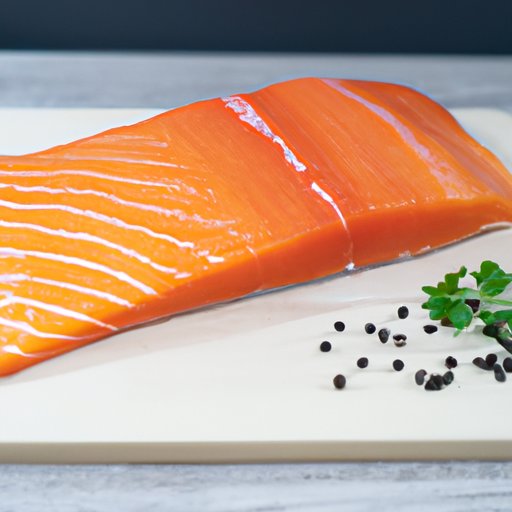
Introduction
Salmon fillet is a delectable and healthy food that can be cooked in multiple ways, making it a versatile ingredient for any meal of the day. Whether you want to bake, pan-fry, or grill salmon fillet, this article will provide easy-to-follow instructions, delicious seasoning options, quick recipes, and health benefits that will elevate your cooking skills to the next level. So let’s dive in and learn how to cook salmon fillet like a pro!
Step-by-step guide
The first step in cooking salmon fillet is to select the best quality fish you can find. Look for bright color, firm texture, and no fishy smell. You can buy fresh or frozen salmon fillet, depending on your preference and availability.
For baking salmon fillet, preheat the oven to 375°F. Pat dry the fish with paper towels and place it skin-side down on a baking dish. Season with salt, pepper, and any other desired seasoning (such as lemon zest, garlic, or herbs). Add a bit of butter or olive oil on top of the salmon fillet. Bake for 12-15 minutes or until the internal temperature reaches 145°F.
For pan-frying salmon fillet, heat a non-stick pan over medium-high heat. Season the fish with salt and pepper. Add a bit of oil or butter to the pan. Place the salmon fillet skin-side up first and cook for 3-4 minutes. Then flip it over and cook for an additional 2-3 minutes. Again, check the internal temperature to ensure it’s cooked thoroughly.
For grilling salmon fillet, preheat the grill to medium heat. Brush the fish with oil and season with preferred seasonings. Place it on the grill skin-side down and cook for 5-6 minutes, then flip it over and cook for another 3-4 minutes. Serve hot.
Best seasoning options
The classic seasoning options for salmon fillet are simple but effective: salt, pepper, lemon, and dill. However, if you want to try something new, you can experiment with various spices, herbs, sauces, or marinades that will complement the fish and your taste buds. For instance, you can try Cajun seasoning, smoked paprika, soy sauce, honey-mustard marinade, or pesto. Make sure to balance the seasoning with the natural flavor of salmon fillet, and don’t overdo it.
Easy recipes
Here are two easy recipes you can make with salmon fillet:
Baked salmon with garlic and herbs: In addition to the basic seasoning, mix minced garlic, chopped parsley, and thyme in a bowl. Spread the mixture evenly over the salmon fillet before baking. Garnish with lemon wedges, if desired.
Pan-fried salmon with lemon butter sauce: After pan-frying the salmon fillet, remove it from the pan and keep it warm. In the same pan, melt a tablespoon of butter and add a tablespoon of lemon juice. Whisk until the sauce is smooth. Pour the sauce over the salmon fillet and serve immediately.
Tips and tricks
To make the best salmon fillet, follow these tips and tricks:
- When thawing frozen salmon, do it slowly in the refrigerator or under cold running water, not at room temperature or in the microwave (which will affect the texture).
- When seasoning salmon fillet, start with a small amount and add gradually to achieve the desired taste.
- When cooking salmon fillet, keep an eye on the temperature and avoid overcooking it, as it will make the fish dry and tough.
- When checking for doneness, use a meat thermometer or fork to test the thickest part of the fillet. The flesh should be opaque but still moist.
- When handling salmon fillet, use a clean cutting board and sharp knife to prevent contamination and maintain the shape of the fillet.
Health benefits
Salmon fillet is not only delicious but also highly nutritious. It is a rich source of omega-3 fatty acids, which can lower the risk of heart disease, stroke, and inflammation. It also contains high-quality protein, vitamins (such as B12 and D), and minerals (such as iron and calcium). Cooking salmon fillet properly can maximize these health benefits and boost your overall well-being.
Serving suggestions
Here are some ideas for serving salmon fillet in creative and tasty ways:
- Pair it with roasted vegetables, such as asparagus, brussels sprouts, or sweet potatoes. The contrast of textures and flavors will make the dish more wholesome.
- Serve it with a side of grains, such as brown rice, quinoa, or couscous. These will provide a complete protein source and complement the mildness of the salmon.
- Add it to a salad, such as Caesar salad, Greek salad, or spinach salad. The salmon will add color and substance to the salad and make it more satisfying.
- Make it into a sandwich, such as a salmon burger, a bagel sandwich, or a wrap. The salmon will become the centerpiece of the sandwich and offer a healthy alternative to meat.
- Top it with a fruit salsa, such as mango salsa, pineapple salsa, or peach salsa. The sweetness of the fruit will balance the savory taste of salmon and give it a tropical twist.
Conclusion
Cooking salmon fillet is not complicated, but it requires attention to detail and creativity. By following the step-by-step guide, trying out different seasonings, experimenting with easy recipes, and applying the tips and tricks, you can become a master of salmon fillet and impress your family and friends. Remember, salmon fillet not only tastes good but also does good to your body. So don’t hesitate to include it in your diet and explore its potential.




